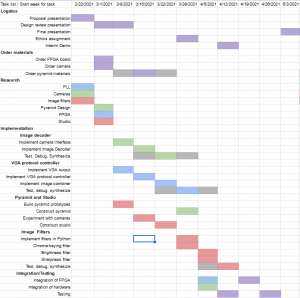This week, our team worked on our design review presentation and decided on the identity of our important hardware, and then we subsequently ordered OV7670 cameras and a DE2-115 board, which should arrive early next week.
We decided on the OV7670 cameras for the reasons mentioned previously in Jullia’s last status report: it is the analog camera that supports our requirements (analog output) and also has the most supporting literature, as it is a common camera used with FPGA. These cameras are also relatively inexpensive and only used up <$30 of our budget. We also decided on the DE2-115 (Cyclone IV) board, over other FPGA alternatives such as the DE0-CV (Cyclone V), for the following reasons: The DE2-115 board has a large number of logic elements and enough SDRAM to support storing a frame of image data as well as the necessary modules to interface with cameras and FPGA. The DE2-115 board has a sufficient number of GPIO pins to support four OV7670 cameras, with the use of a daughter board. This board is also within the ECE department’s parts inventory and thus easy (and free) to acquire and use, for the duration of our Capstone project.
This aforementioned hardware represents our current, most significant risk: successfully interfacing with four OV7670s cameras with the FPGA board. We need to link together the cameras’ control and data lines with the FPGA, which could be 72 pins at maximum. Some of these connections should be able to be linked together or otherwise not connected to GPIO pins, such as power and ground. However, this is a large enough number of needed GPIO connections that requires us to most likely need to buy a daughter board in order to have additional GPIO connections on the DE2-115 board. We have a couple risk mitigation plans if the daughter board does not work: One plan is to ignore a data line from each camera, the LSB of color data, in order to manage the connections. At absolutely worst, we can also create a holographic pyramid with less than four cameras, projecting fewer than four side-views of the object onto the pyramid.
We have also updated our schedule in order to prioritize the most critical components of our project, pushing back the implementation of image filters in favor of implementing the pyramid and live studio earlier. This schedule is shown below:

